Petawatt Femtosecond Laser Pulses from Titanium-Doped Sapphire Crystal
Abstract
1. Introduction
2. Petawatt Femtosecond J-KAREN-P Laser System
2.1. Overall System
2.2. Front-End-First, CPA System
2.3. OPCPA Pre-Amplifier
2.4. Ti:sapphire Pre-Amplifier and Power Amplifier
2.5. Ti:sapphire Booster Amplifiers 1 and 2
2.6. Recompressed Pulse Duration and Focusability
3. Investigation of Temporal Contrast in the J-KAREN-P Laser System
3.1. Real Pre-Pulses’ Generation by Post-Pulses
3.2. Temporal Contrast Improvement
4. Applications with the J-KAREN-P Laser System
5. Conclusions
Author Contributions
Funding
Acknowledgments
Conflicts of Interest
References
- Backus, S.; Durfee, C.G., III; Murnane, M.M.; Kapteyn, H.C. High power ultrafast lasers. Rev. Sci. Instrum. 1998, 69, 1207–1223. [Google Scholar] [CrossRef]
- McClung, F.J.; Hellwarth, R. Giant optical pulsations from Ruby. J. Appl. Phys. 1962, 33, 828–829. [Google Scholar] [CrossRef]
- Mocker, H.W.; Collins, R.J. Mode competition and self-locking effects in a Q-switched ruby laser. Appl. Phys. Lett. 1965, 7, 270–273. [Google Scholar] [CrossRef]
- de Maria, A.J.; Stetser, D.A.; Heynau, H. Self mode-locking of lasers with saturable absorbers. Appl. Phys. Lett. 1966, 7, 174–176. [Google Scholar] [CrossRef]
- Strickland, D.; Mourou, G. Compression of amplified chirped optical pulses. Opt. Commun. 1985, 56, 219–221. [Google Scholar]
- Moulton, P.F. Spectroscopic and laser characteristics of Ti:Al2O3. J. Opt. Soc. Am. B 1986, 3, 125–133. [Google Scholar] [CrossRef]
- Yu, T.J.; Lee, S.K.; Sung, J.H.; Yoon, J.W.; Jeong, T.M.; Lee, J. Generation of high-contrast, 30 fs, 1.5 PW laser pulses from chirped-pulse amplification Ti: Sapphire laser. Opt. Express 2012, 20, 10807–10815. [Google Scholar] [CrossRef]
- Laux, S.; Lureau, F.; Radier, C.; Chalus, O.; Caradec, F.; Casagrande, O.; Pourtal, E.; Simon-Boisson, C.; Soyer, F.; Lebarny, P. Suppression of parasitic lasing in high energy, high repetition rate Ti: Sapphire laser amplifiers. Opt. Lett. 2012, 37, 1913–1915. [Google Scholar] [CrossRef]
- Kiriyama, H.; Shimomura, T.; Sasao, H.; Nakai, Y.; Tanoue, M.; Kondo, S.; Kanazawa, S.; Pirozhkov, A.S.; Mori, M.; Fukuda, Y.; et al. Temporal contrast enhancement of petawatt-class laser pulses. Opt. Lett. 2012, 37, 3363–3365. [Google Scholar] [CrossRef]
- Danson, C.; Hillier, D.; Hopps, N.; Neely, D. Petawatt class lasers worldwide. High Power Laser Sci. Eng. 2015, 3, e3. [Google Scholar] [CrossRef]
- Jeong, T.M.; Lee, J. Femtosecond petawatt laser. Ann. Phys. 2014, 526, 157–172. [Google Scholar] [CrossRef]
- Yakovlev, I.V. Stretchers and compressors for ultra-high power laser systems. Quantum Electron. 2014, 44, 393–414. [Google Scholar] [CrossRef]
- Danson, C.N.; Haefner, C.; Bromage, J.; Butcher, T.; Chanteloup, J.-C.F.; Chowdhury, E.A.; Galvanauskas, A.; Gizzi, L.A.; Hein, J.; Hillier, D.I.; et al. Petawatt and exawatt class lasers worldwide. High Power Laser Sci. Eng. 2019, 7, e54. [Google Scholar] [CrossRef]
- Sung, J.H.; Lee, H.W.; Yoo, J.Y.; Yoon, J.W.; Lee, C.W.; Yang, J.M.; Son, Y.J.; Jang, Y.H.; Lee, S.K.; Nam, C.H. 4.2 PW, 20 fs Ti: Sapphire laser at 0.1 Hz. Opt. Lett. 2017, 42, 2058–2061. [Google Scholar] [CrossRef] [PubMed]
- Center for Advanced Laser Applications. Available online: http://www.cala-laser.de (accessed on 28 May 2020).
- Li, W.; Gan, Z.; Yu, L.; Wang, C.; Liu, Y.; Guo, Z.; Xu, L.; Xu, M.; Hang, Y.; Xu, Y.; et al. 339 J high-energy Ti: Sapphire chirped-pulse amplifier for 10 PW laser facility. Opt. Lett. 2018, 43, 5681–5684. [Google Scholar] [CrossRef] [PubMed]
- eli Nuclear Physics. Available online: https://www.eli-np.ro (accessed on 28 May 2020).
- Wang, Y.; Wang, S.; Rockwood, A.; Luther, B.M.; Hollinger, R.; Curtis, A.; Calvi, C.; Menoni, C.S.; Rocca, J.J. 0.85 PW laser operation at 3.3 Hz and high-contrast ultrahigh-intensity λ = 400 nm second-harmonic beamline. Opt. Lett. 2017, 42, 3828–3831. [Google Scholar] [CrossRef] [PubMed]
- eli Beamlines. Available online: https://www.eli-beams.eu/facility/lasers/laser-3-hapls-1-pw-30-j-10-hz/ (accessed on 28 May 2020).
- Dubietis, A.; Jonusauskas, G.; Piskarskas, A. Powerful femtosecond pulse generation by chirped and stretched pulse parametric amplification in BBO crystal. Opt. Commun. 1992, 88, 437–440. [Google Scholar] [CrossRef]
- Ross, I.N.; Matousek, P.; Towrie, M.; Langley, A.J.; Collier, J.L. The prospects for ultrashort pulse duration and ultrahigh intensity using optical parametric chirped pulse amplifiers. Opt. Commun. 1997, 144, 125–133. [Google Scholar] [CrossRef]
- Zeng, X.; Zhou, K.; Zuo, Y.; Zhu, Q.; Su, J.; Wang, X.; Wang, X.; Huang, X.; Jiang, X.; Jiang, D.; et al. Multi-petawatt laser facility fully based on optical parametric chirped-pulse amplification. Opt. Lett. 2017, 42, 2014–2017. [Google Scholar] [CrossRef]
- Marriage of a 20keV Superconducting XFEL with a 100PW Laser. Available online: https://spie.org/news/marriage-of-a-20kev-superconducting-xfel-with-a-100pw-laser (accessed on 28 May 2020).
- Pirozhkov, A.S.; Fukuda, Y.; Nishiuchi, M.; Kiriyama, H.; Sagisaka, A.; Ogura, K.; Mori, M.; Kishimoto, M.; Sakaki, H.; Dover, N.P.; et al. Approaching the diffraction-limited, bandwidth-limited Petawatt. Opt. Express 2017, 25, 20486–20501. [Google Scholar] [CrossRef]
- Guo, Z.; Yu, L.; Wang, J.; Wang, C.; Liu, Y.; Gan, Z.; Li, W.; Leng, Y.; Liang, X.; Li, R. Improvement of the focusing ability by double deformable mirrors for 10-PW-level Ti: Sapphire chirped pulse amplification laser system. Opt. Express 2018, 26, 26776–26786. [Google Scholar] [CrossRef] [PubMed]
- Yoon, J.W.; Jeon, C.; Shin, J.; Lee, S.K.; Lee, H.W.; Choi, I.W.H.; Kim, T.; Sung, J.H.; Nam, C.H. Achieving the laser intensity of 5.5 × 1022 W/cm2 with a wavefront-corrected multi-PW laser. Opt. Express 2019, 27, 20412–20420. [Google Scholar] [CrossRef]
- Ivanov, V.V.; Maksimchuk, A.; Mourou, G. Amplified spontaneous emission in a Ti: Sapphire regenerative amplifier. Appl. Opt. 2003, 42, 7231–7234. [Google Scholar] [CrossRef] [PubMed]
- Didenko, N.V.; Konyashchenko, A.V.; Lutsenko, A.P.; Tenyakov, S.Y. Contrast degradation in a chirped-pulse amplifier due to generation of prepulses by postpulses. Opt. Express 2008, 16, 3178–3190. [Google Scholar] [CrossRef] [PubMed]
- Khodakovskiy, N.; Kalashinikov, M.; Gontier, E.; Falcoz, F.; Paul, P.-M. Degradation of picosecond temporal contrast of Ti: Sapphire lasers with coherent pedestals. Opt. Lett. 2016, 41, 4441–4444. [Google Scholar] [CrossRef] [PubMed]
- Kiriyama, H.; Mashiba, Y.; Miyasaka, Y.; Asakawa, M.R. Random spectral phase noise effect on the temporal contrast of ultra-high intensity laser pulse. Rev. Laser Eng. 2018, 46, 142–144. [Google Scholar]
- Thaury, C.; Quéré, F.; Geindre, J.-P.; Levy, A.; Ceccotti, T.; Monot, P.; Bougeard, M.; Réau, F.; d’Oliveira, P.; Audebert, P.; et al. Plasma mirrors for ultrahigh-intensity optics. Nat. Phys. 2007, 3, 424–429. [Google Scholar] [CrossRef]
- Kalashnikov, M.P.; Risse, E.; Schönnagel, H.; Sandner, W. Double chirped-pulse-amplification laser: A way to clean pulses temporally. Opt. Lett. 2005, 30, 923–925. [Google Scholar] [CrossRef]
- Jullien, A.; Albert, O.; Burgy, F.; Hamoniaux, G.; Rousseau, J.-P.; Chambaret, J.-P.; Augé-Rochereau, F.; Chériaux, G.; Etchepare, J.; Minkovski, N.; et al. 10−10 temporal contrast for femtosecond ultraintense lasers by cross-polarized wave generation. Opt. Lett. 2005, 30, 920–922. [Google Scholar] [CrossRef]
- Yu, L.; Xu, Y.; Liu, Y.; Li, Y.; Li, S.; Liu, Z.; Li, W.; Wu, F.; Yang, X.; Yang, Y.; et al. High-contrast front end based on cascaded XPWG and femtosecond OPA for 10-PW-level Ti: Sapphire laser. Opt. Express 2018, 26, 2625–2633. [Google Scholar] [CrossRef]
- Schimpf, D.N.; Seise, E.; Limpert, J.; Tünnermann, A. Decrease of pulse-contrast in nonlinear chirped-pulse amplification systems due to high-frequency spectral phase ripples. Opt. Express 2008, 16, 8876–8886. [Google Scholar] [CrossRef] [PubMed]
- Keppler, S.; Hornung, M.; Bodefeld, R.; Kahle, M.; Hein, J.; Kaluza, M.C. All-reflective, highly accurate polarization rotator for high-power short-pulse laser systems. Opt. Express 2018, 20, 20742–20747. [Google Scholar] [CrossRef] [PubMed]
- Schanz, V.A.; Brabetz, C.; Posor, D.J.; Reemts, D.; Roth, M.; Bagnoud, V. High dynamic range, large temporal domain laser pulse measurement. Appl. Phys. B 2019, 125, 61. [Google Scholar] [CrossRef]
- Kiriyama, H.; Miyasaka, Y.; Sagisaka, A.; Ogura, K.; Nishiuchi, M.; Pirozhkov, A.S.; Fukuda, Y.; Kando, M.; Kondo, K. Experimental investigation on the temporal contrast of pre-pulses by post-pulses in a petawatt laser facility. Opt. Lett. 2020, 45, 1100–1103. [Google Scholar] [CrossRef]
- Kiriyama, H.; Mori, M.; Pirozhkov, A.S.; Ogura, K.; Sagisaka, A.; Kon, A.; Esirkepov, T.Z.; Hayashi, Y.; Kotaki, H.; Kanasaki, M.; et al. High-contrast, high-intensity petawatt-class laser and applications. IEEE J. Sel. Top. Quantum Electron. 2015, 21, 1601118. [Google Scholar] [CrossRef]
- Kiriyama, H.; Pirozhkov, A.S.; Nishiuchi, M.; Fukuda, Y.; Ogura, K.; Sagisaka, A.; Miyasaka, Y.; Mori, M.; Sakaki, H.; Dover, N.P.; et al. High-contrast high-intensity repetitive petawatt laser. Opt. Lett. 2018, 43, 2595–2598. [Google Scholar] [CrossRef]
- Kiriyama, H.; Pirozhkov, A.S.; Nishiuchi, M.; Fukuda, Y.; Ogura, K.; Sagisaka, A.; Miyasaka, Y.; Sakaki, H.; Dover, N.P.; Kondo, K.; et al. Status and progress of the J-KAREN-P high intensity laser system at QST. High Energy Density Phys. 2020, 36, 100771. [Google Scholar] [CrossRef]
- Cheriaux, G.; Rousseau, P.; Salin, F.; Chambaret, J.P.; Walker, B.; Dimauro, L.F. Aberration-free stretcher design for ultrashort-pulse amplification. Opt. Lett. 1996, 21, 414–416. [Google Scholar] [CrossRef]
- Kiriyama, H.; Mori, M.; Nakai, Y.; Shimomura, T.; Tanoue, M.; Akutsu, A.; Kondo, S.; Kanazawa, S.; Okada, H.; Motomura, T.; et al. High-contrast, high-intensity laser pulse generation using a nonlinear preamplifier in a Ti: Sapphire laser system. Opt. Lett. 2008, 33, 645–647. [Google Scholar] [CrossRef]
- Kiriyama, H.; Mori, M.; Nakai, Y.; Yamamoto, Y.; Tanoue, M.; Akutsu, A.; Shimomura, T.; Kondo, S.; Kanazawa, S.; Daido, H.; et al. High-energy, high-contrast, multiterawatt laser pulses by optical parametric chirped-pulse amplification. Opt. Lett. 2007, 32, 2315–2317. [Google Scholar] [CrossRef]
- Hello, P.; Man, C.N. Design of a low-loss off-axis beam expander. Appl. Opt. 1996, 35, 2534–2536. [Google Scholar] [CrossRef] [PubMed]
- Frantz, L.M.; Nodvik, J.S. Theory of pulse propagation in a laser amplifier. J. Appl. Phys. 1963, 34, 2346–2349. [Google Scholar] [CrossRef]
- Oksenhendler, T.; Courdreau, S.; Forget, N.; Crozatier, V.; Grabielle, S.; Herzog, R.; Gobert, O.; Kaplan, D. Self-referenced spectral interferometry. Appl. Phys. B 2010, 99, 7–12. [Google Scholar] [CrossRef]
- Daido, H.; Nishiuchi, M.; Pirozhkov, A.S. Review of laser-driven ion sources and their applications. Rep. Prog. Phys. 2012, 75, 056401–056471. [Google Scholar] [CrossRef]
- Nishiuchi, M.; Kiriyama, H.; Sakaki, H.; Dover, N.P.; Kondo, K.; Pirozhkov, A.S.; Sagisaka, A.; Fukuda, Y.; Nishitani, K.; Miyahara, T.; et al. Ion acceleration experiment with the high intensity, high contrast J-KAREN-P laser system. Rev. Laser Eng. 2018, 46, 145–147. [Google Scholar]
- Dover, N.P.; Nishiuchi, M.; Sakaki, H.; Kondo, K.; Lowe, H.F.; Alkhimova, M.A.; Ditter, E.J.; Ettlinger, O.C.; Faenov, A.Y.; Hata, M.; et al. Demonstration of repetitive energetic proton generation by ultra-intense laser interaction with a tape target. High Energy Density Phys. 2020, 37, 100847. [Google Scholar] [CrossRef]
- Dover, N.P.; Nishiuchi, M.; Sakaki, H.; Kondo, K.; Alkhimova, M.A.; Faenov, A.; Hata, M.; Iwata, N.; Kiriyama, H.; Koga, J.; et al. Effect of Small Focus on Electron Heating and Proton Acceleration in Ultrarelativistic Laser-Solid Interactions. Phys. Rev. Lett. 2020, 124, 084802-1–084802-7. [Google Scholar]
- Nishiuchi, M.; Sakaki, H.; Esirkepov, T.Z.; Nishio, K.; Pikuz, T.A.; Faenov, A.Y.; Skobelev, I.Y.; Orlandi, R.; Sako, H.; Pirozhkov, A.S.; et al. Acceleration of highly charged GeV Fe ions from a low-Z substrate by intense femtosecond laser. Phys. Plasmas 2015, 22, 033107-1–033107-8. [Google Scholar] [CrossRef]
- Nishiuchi, M.; Sakaki, H.; Esirkepov, T.Z.; Nishio, K.; Pikuz, T.A.; Faenov, A.Y.; Skobelev, I.Y.; Orlandi, R.; Pirozhkov, A.S.; Sagisaka, A.; et al. Towards a novel laser-driven method of exotic nuclei extraction−acceleration for fundamental physics and technology. Plasma Phys. Rep. 2016, 42, 327–337. [Google Scholar] [CrossRef]
- Nishiuchi, M.; Dover, N.P.; Hata, M.; Sakaki, H.; Kondo, K.; Lowe, H.F.; Miyahara, T.; Kiriyama, H.; Koga, J.K.; Iwata, N.; et al. Dynamics of Laser-driven Heavy Ion Acceleration Clarified by Ion Charge States. Phys. Rev. Res. 2020, 2, 033081. [Google Scholar] [CrossRef]
- Pirozhkov, A.S.; Kando, M.; Esirkepov, T.Z.; Gallegos, P.; Ahmed, H.; Ragozin, E.N.; Faenov, A.Y.; Pikuz, T.A.; Kawachi, T.; Sagisaka, A.; et al. Soft-X-Ray Harmonic Comb from Relativistic Electron Spikes. Phys. Rev. Lett. 2012, 108, 135004. [Google Scholar] [CrossRef] [PubMed]
- Pirozhkov, A.S.; Kando, M.; Esirkepov, T.Z.; Gallegos, P.; Ahmed, H.; Ragozin, E.N.; Faenov, A.Y.; Pikuz, T.A.; Kawachi, T.; Sagisaka, A.; et al. High order harmonics from relativistic electron spikes. New J. Phys. 2014, 16, 093003. [Google Scholar] [CrossRef]
- Pirozhkov, A.S.; Esirkepov, T.Z.; Pikuz, T.A.; Faenov, A.Y.; Ogura, K.; Hayashi, Y.; Kotaki, H.; Ragozin, E.N.; Neely, D.; Kiriyama, H.; et al. Burst intensification by singularity emitting radiation in multi-stream flows. Sci. Rep. 2017, 7, 17968. [Google Scholar] [CrossRef] [PubMed]
- Pirozhkov, A.S.; Esirkepov, T.Z.; Pikuz, T.A.; Faenov, A.Y.; Sagisaka, A.; Ogura, K.; Hayashi, Y.; Kotaki, H.; Ragozin, E.N.; Neely, D.; et al. Laser Requirements for High-Order Harmonic Generation by Relativistic Plasma Singularities. Quantum Beam Sci. 2018, 2, 7. [Google Scholar] [CrossRef]
- Sagisaka, A.; Ogura, K.; Esirkepov, T.Z.; Neely, D.; Pikuz, T.A.; Koga, J.K.; Fukuda, Y.; Kotaki, H.; Hayashi, Y.; Gonzalez-Izquierdo, B.; et al. Observation of Burst Intensification by Singularity Emitting Radiation generated from relativistic plasma with a high-intensity laser. High Energy Density Phys. 2020, 36, 100751. [Google Scholar] [CrossRef]
- Jinno, S.; Tanaka, H.; Matsui, R.; Kanasaki, M.; Sakaki, H.; Kando, M.; Kondo, K.; Sugiyama, A.; Uesaka, M.; Kishimoto, Y.; et al. Characterization of micron-size hydrogen clusters using Mie scattering. Opt. Express 2017, 25, 18774–18783. [Google Scholar] [CrossRef]
- Jinno, S.; Kanasaki, M.; Uno, M.; Matsui, R.; Uesaka, M.; Kishimoto, Y.; Fukuda, Y. Micron-size hydrogen cluster target for laser-driven proton acceleration. Plasma Phys. Control. Fusion 2018, 60, 044021. [Google Scholar] [CrossRef]
- Matsui, R.; Fukuda, Y.; Kishimoto, Y. Quasimonoenergetic proton bunch acceleration driven by hemispherically converging collisionless shock in a hydrogen cluster coupled with relativistically induced transparency. Phys. Rev. Lett. 2019, 122, 014804-1–014804-6. [Google Scholar] [CrossRef]
- Asai, A.; Kanasaki, M.; Jinno, S.; Kitagawa, N.; Shutoh, N.; Kodaira, S.; Yamauchi, T.; Oda, K.; Morishima, K.; Fukuda, Y. Application of nuclear emulsions for the identi cation of multi-MeV protons in laser ion acceleration experiments. High Energy Density Phys 2019, 32, 44–50. [Google Scholar] [CrossRef]
- Faenov, A.Y.; Colgan, J.; Hansen, S.B.; Zhidkov, A.; Pikuz, T.A.; Nishiuchi, M.; Pikuz, S.A.; Skobelev, I.Y.; Abdallah, J.; Sakaki, H.; et al. Nonlinear increase of X-ray intensities from thin foils irradiated with a 200 TW femtosecond laser. Sci. Rep. 2015, 5, 13436. [Google Scholar] [CrossRef]
- Alkhimova, M.A.; Faenov, A.Y.; Skobelev, I.Y.; Pikuz, T.A.; Nishiuchi, M.; Sakaki, H.; Pirozhkov, A.S.; Sagisaka, A.; Dover, N.P.; Ogura, K.; et al. High resolution X-ray spectra of stainless steel foils irradiated by femtosecond laser pulses with ultra-relativistic intensities. Opt. Express 2017, 25, 29501–29511. [Google Scholar] [CrossRef]
- Bulanov, S.V.; Esirkepov, T.Z.; Hayashi, Y.; Kando, M.; Kiriyama, H.; Koga, J.K.; Kondo, K.; Kotaki, H.; Pirozhkov, A.S.; Bulanov, S.S.; et al. On the design of experiments for the study of extreme field limits in the interaction of laser with ultrarelativistic electron beam. Nucl. Instrum. Methods A 2011, 660, 31–42. [Google Scholar] [CrossRef]
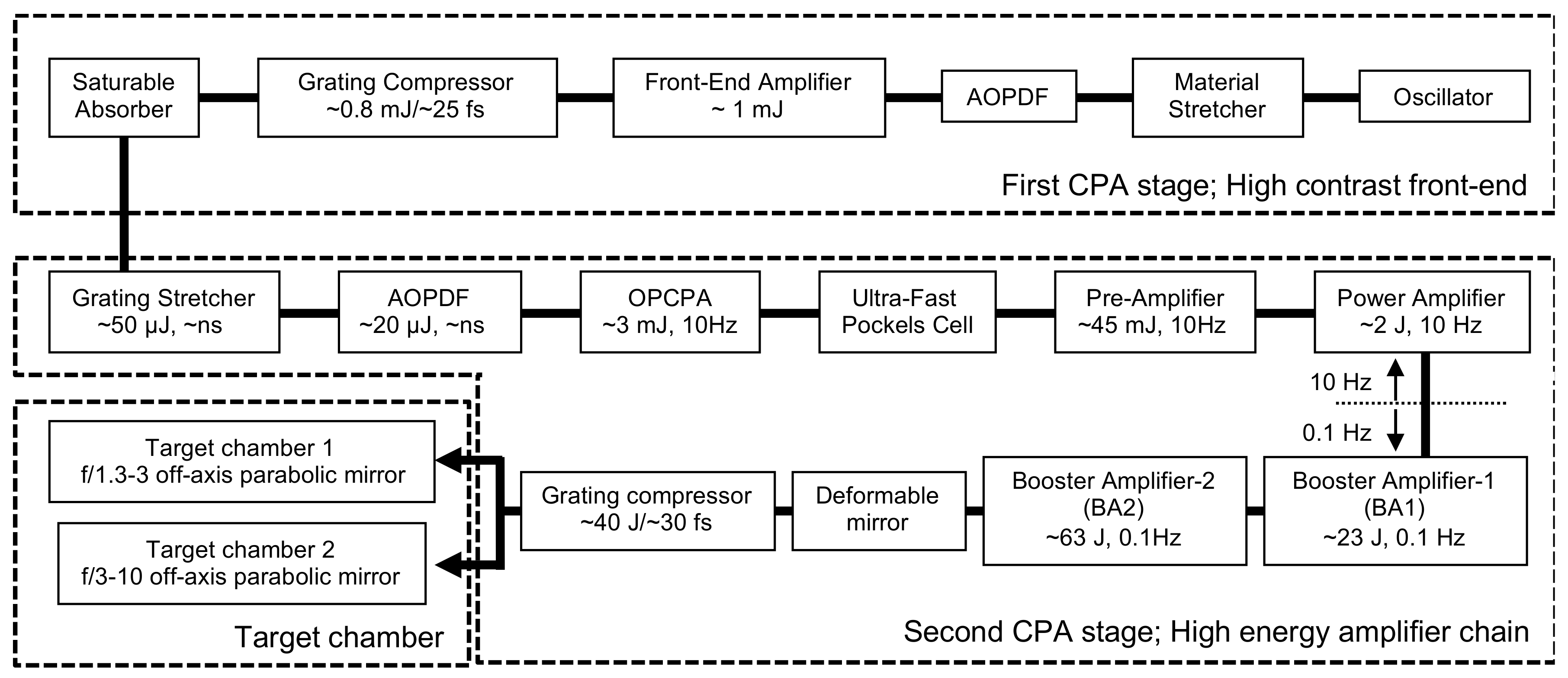

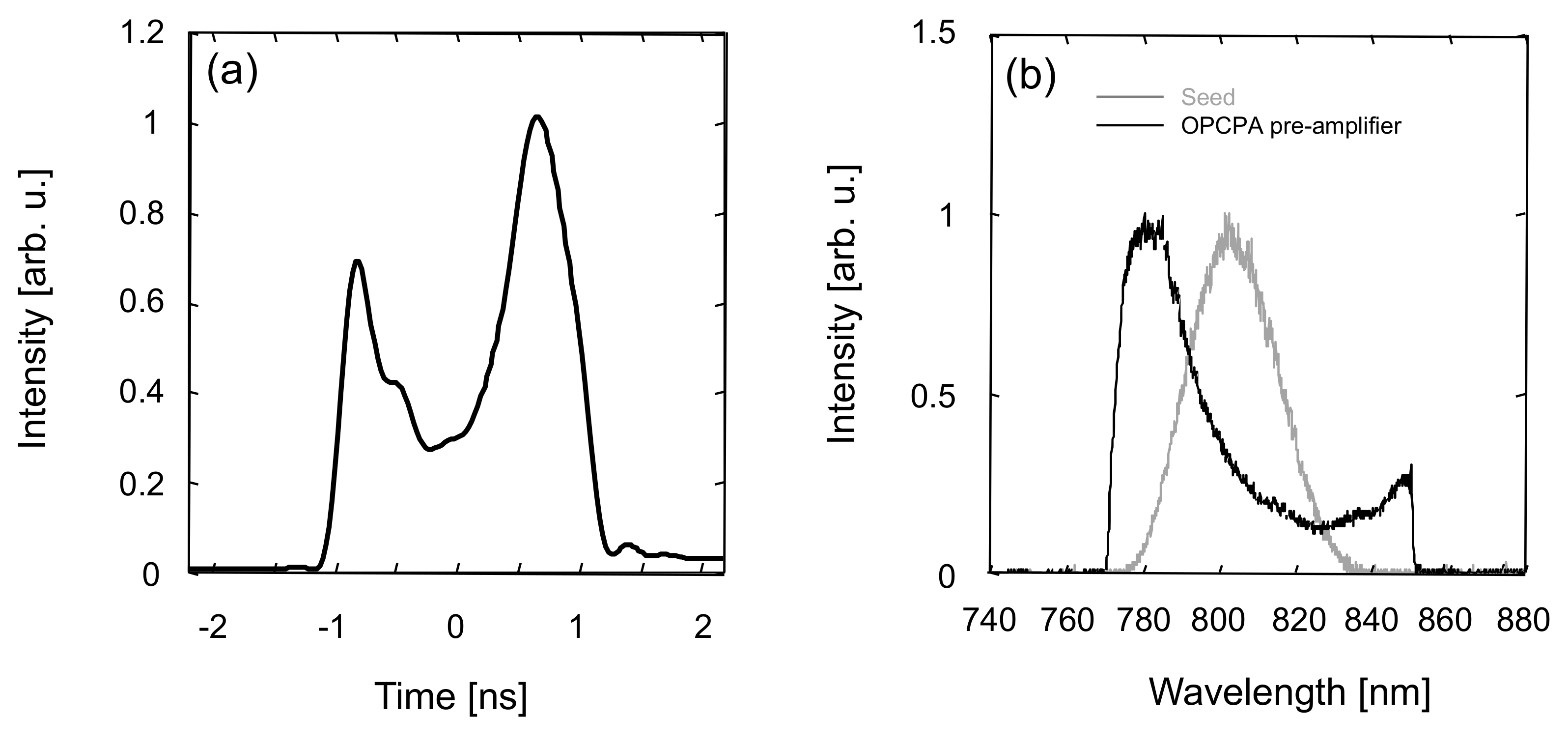

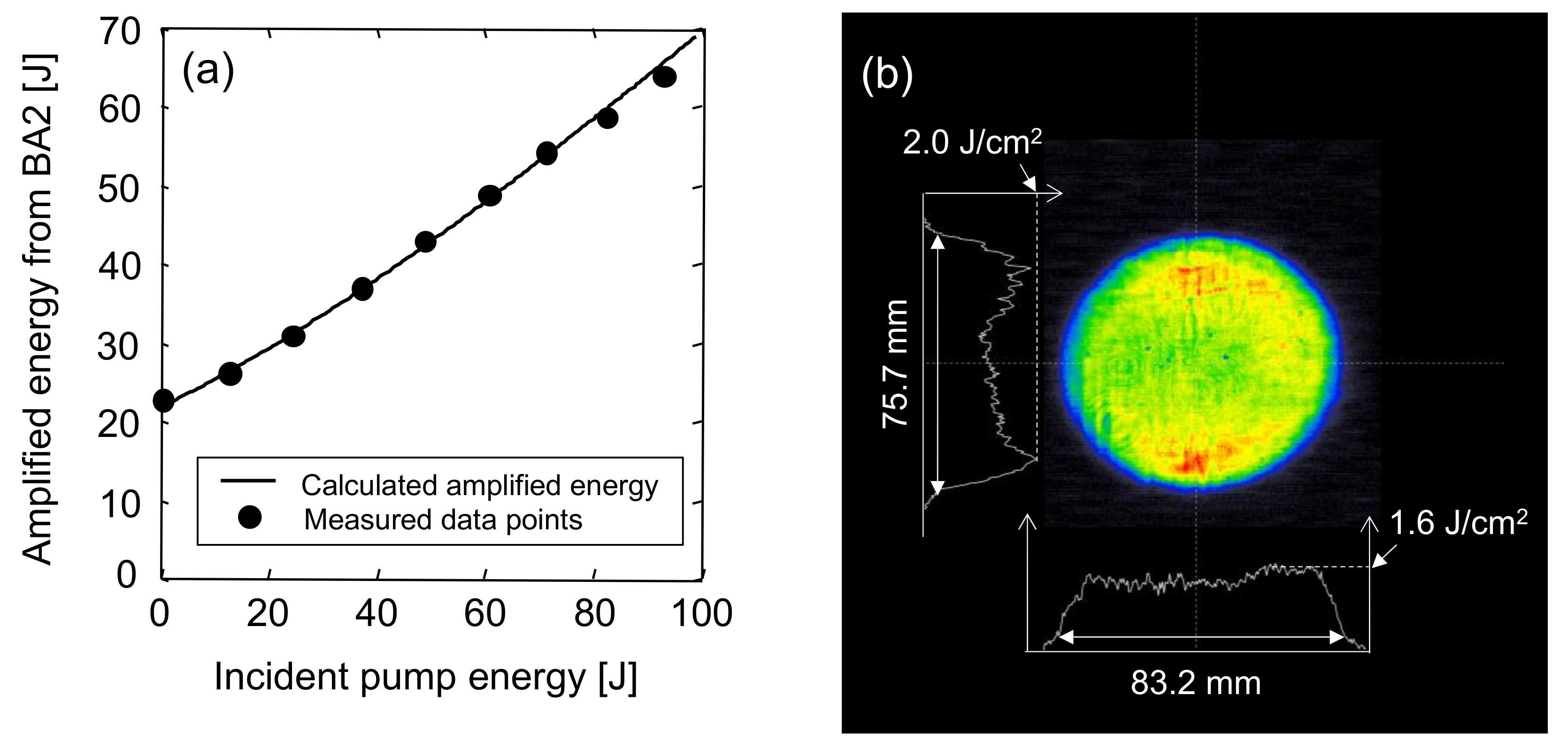



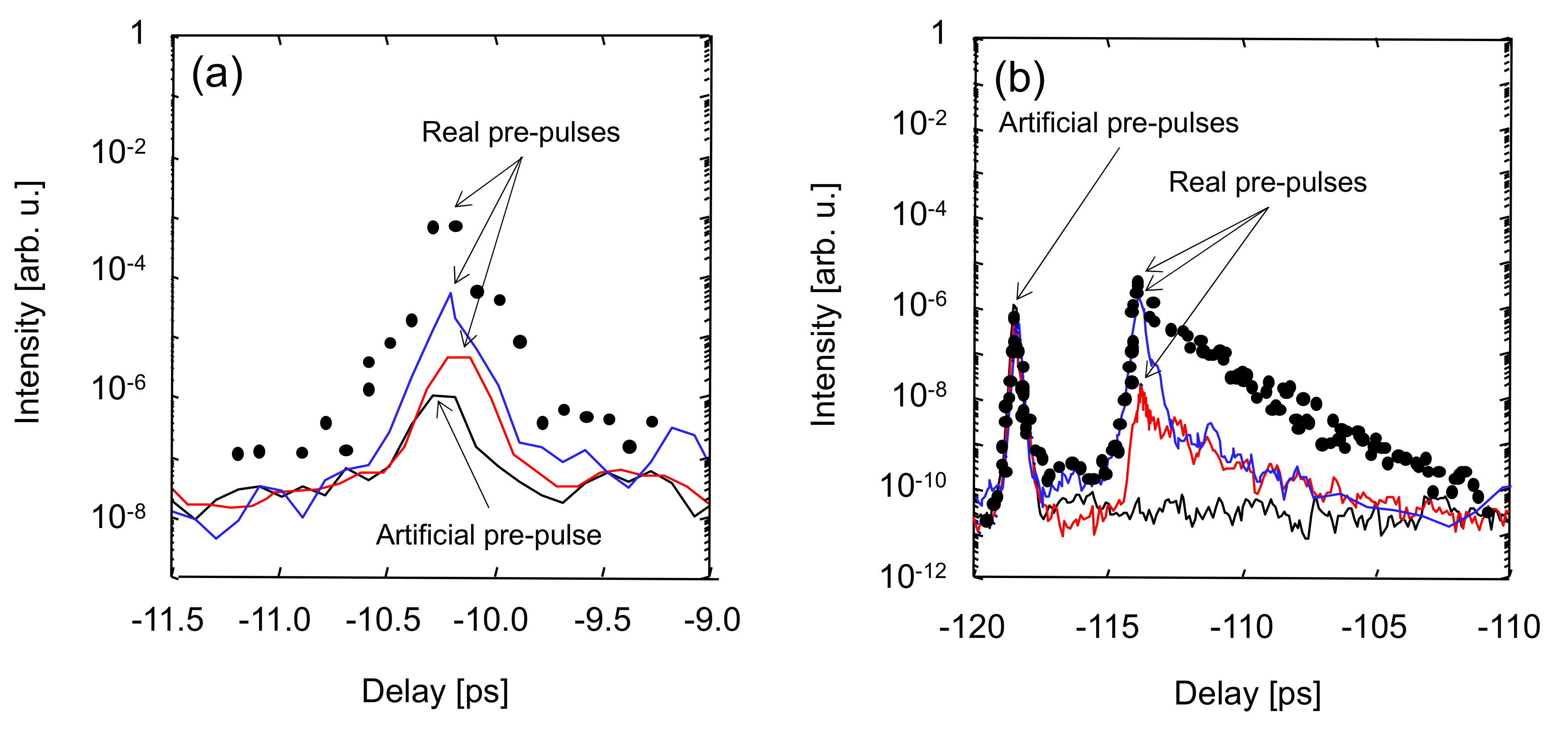
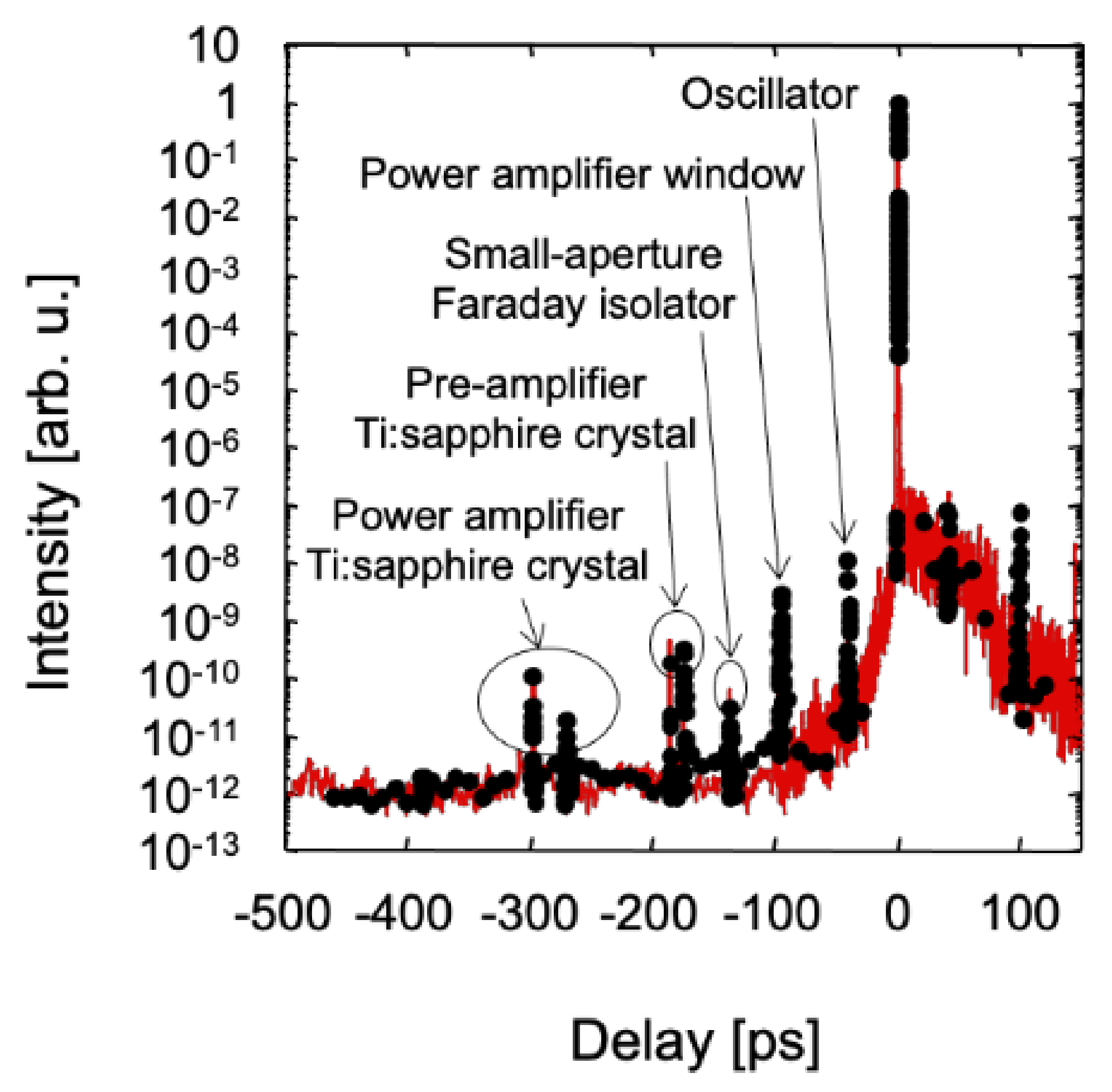
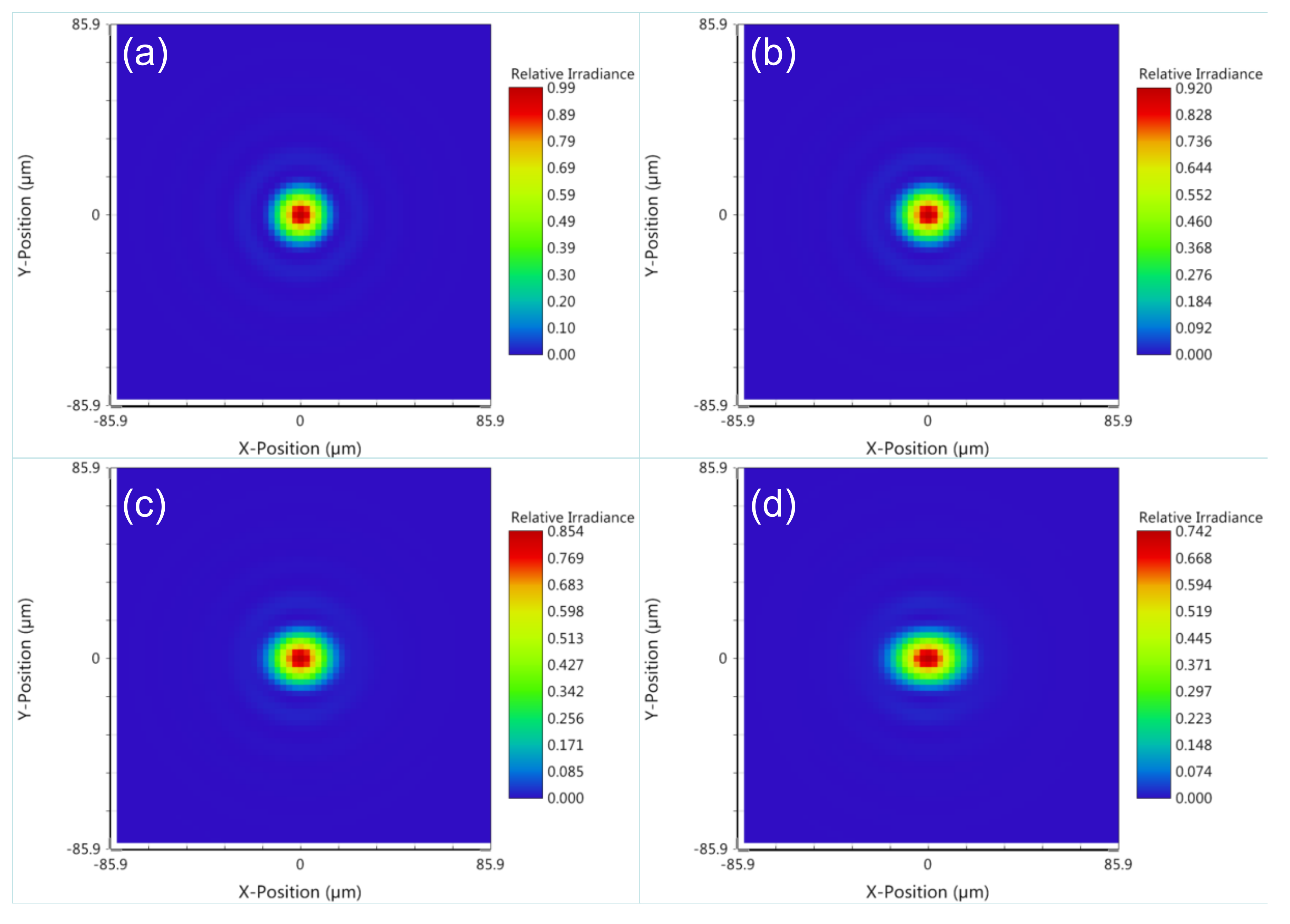
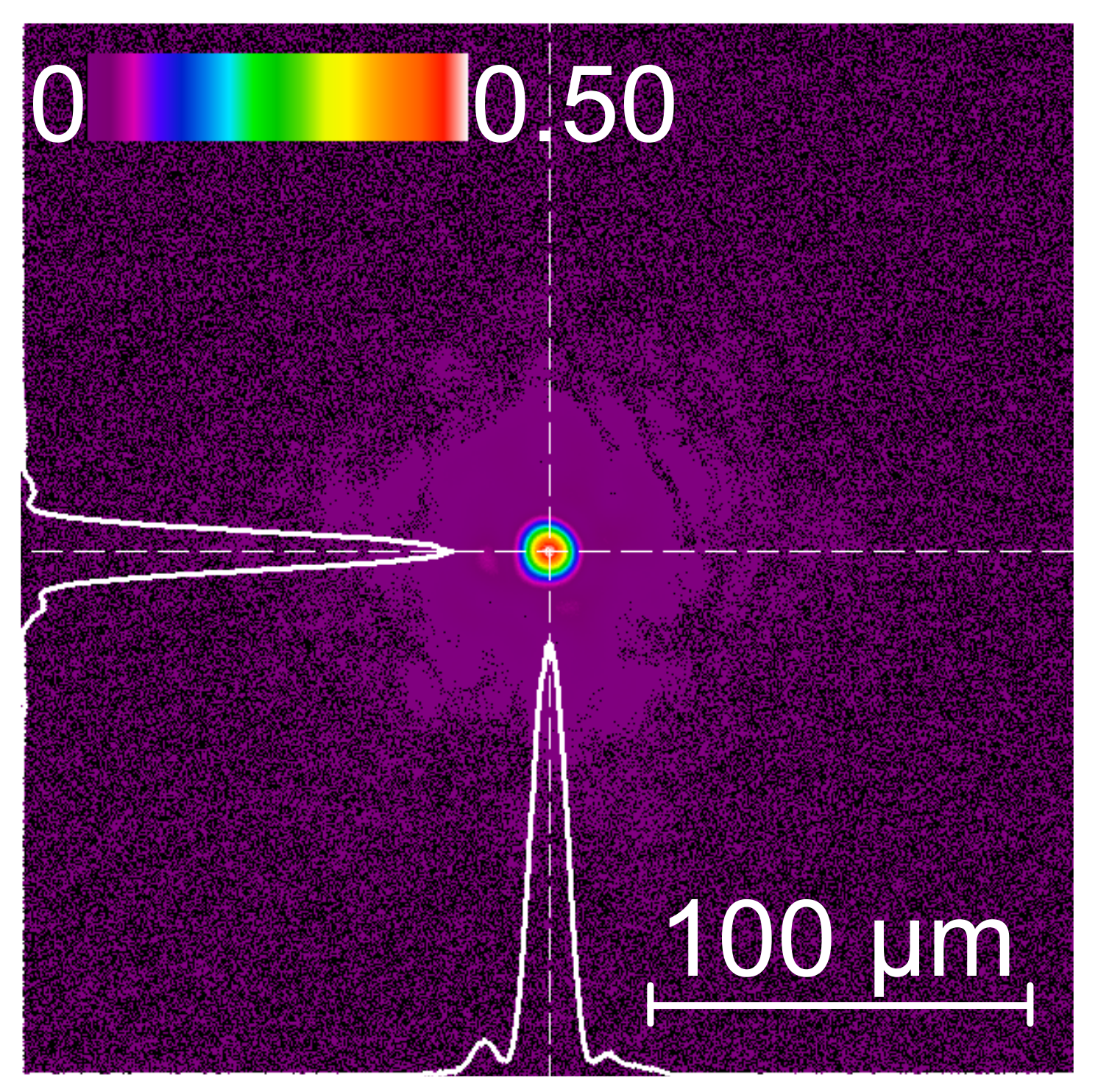


© 2020 by the authors. Licensee MDPI, Basel, Switzerland. This article is an open access article distributed under the terms and conditions of the Creative Commons Attribution (CC BY) license (http://creativecommons.org/licenses/by/4.0/).
Share and Cite
Kiriyama, H.; Pirozhkov, A.S.; Nishiuchi, M.; Fukuda, Y.; Sagisaka, A.; Kon, A.; Miyasaka, Y.; Ogura, K.; Dover, N.P.; Kondo, K.; et al. Petawatt Femtosecond Laser Pulses from Titanium-Doped Sapphire Crystal. Crystals 2020, 10, 783. https://doi.org/10.3390/cryst10090783
Kiriyama H, Pirozhkov AS, Nishiuchi M, Fukuda Y, Sagisaka A, Kon A, Miyasaka Y, Ogura K, Dover NP, Kondo K, et al. Petawatt Femtosecond Laser Pulses from Titanium-Doped Sapphire Crystal. Crystals. 2020; 10(9):783. https://doi.org/10.3390/cryst10090783
Chicago/Turabian StyleKiriyama, Hiromitsu, Alexander S. Pirozhkov, Mamiko Nishiuchi, Yuji Fukuda, Akito Sagisaka, Akira Kon, Yasuhiro Miyasaka, Koichi Ogura, Nicholas P. Dover, Kotaro Kondo, and et al. 2020. "Petawatt Femtosecond Laser Pulses from Titanium-Doped Sapphire Crystal" Crystals 10, no. 9: 783. https://doi.org/10.3390/cryst10090783
APA StyleKiriyama, H., Pirozhkov, A. S., Nishiuchi, M., Fukuda, Y., Sagisaka, A., Kon, A., Miyasaka, Y., Ogura, K., Dover, N. P., Kondo, K., Sakaki, H., Koga, J. K., Esirkepov, T. Z., Huang, K., Nakanii, N., Kando, M., Kondo, K., Bock, S., Ziegler, T., ... Schramm, U. (2020). Petawatt Femtosecond Laser Pulses from Titanium-Doped Sapphire Crystal. Crystals, 10(9), 783. https://doi.org/10.3390/cryst10090783







